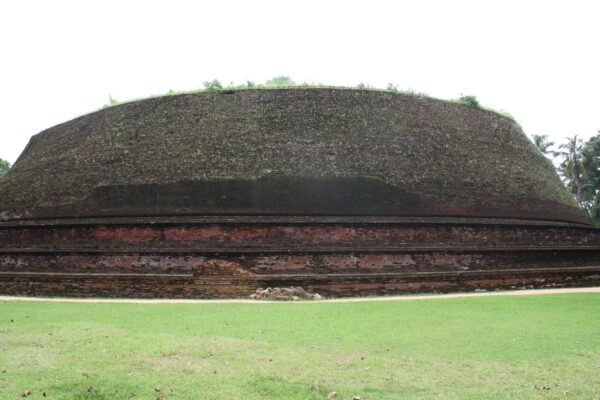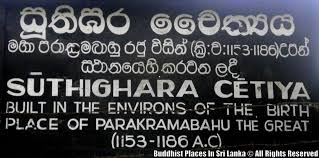“Kota Vehera” – commemoration of a royal birth – By Arundathie Abeysinghe

 Situated approximately 15 kilometers from *Kegalle, Dedigama “Kota Vehera” also known as “Suthigara Seya” or “Suthigara Dagoba” (“suthikagaraya” meaning place of birth) is a dome-shaped shrine comprising relics of the Buddha or an *Arhat.
Situated approximately 15 kilometers from *Kegalle, Dedigama “Kota Vehera” also known as “Suthigara Seya” or “Suthigara Dagoba” (“suthikagaraya” meaning place of birth) is a dome-shaped shrine comprising relics of the Buddha or an *Arhat.
According to *Mahawamsa, King Manabharana, a sub-king of *Ruhuna lived in exile in Dedigama. He has used “Punkhagama” (present Dedigama) as his capital city during his reign. The Suthigara dagoba (or stupa is a shrine that contains sacred relics) gets its name from the word “suthikagaraya” (meaning place of birth). Queen Rathnavali gave birth to a baby boy (who later reigned as King Parakramabahu I also known as King Parakramabahu the Great – 1153-1186) in the place where the stupa is located. This stupa has been constructed by King Parakramabahu as a memorial for the location, he was born.
According to typical architectural style of King Parakramabahu I, the stupa has its hemispherical form truncated on the top, without the usual upper portions of stupas. Hence, it was named as “Kota Vehera” (meaning short stupa in Sinhala).
There are three stupas of “Kota Vehera” type in Sri Lanka: Suthighara Chetiya (Suthighara Stupa) at Dedigama, stupa at *Yudaganawa (largest stupa in the south and east of Sri Lanka) and the Damila thupa at Polonnaruwa (dating to the 12th century and attributed to King Parakramabahu I).
According to folklore, the smaller stupa has been constructed on the exact location of the royal birth (location of King Parakramabahu’s birth) and the larger stupa has been built around it. The larger stupa is approximately 14 meters (47 feet) high and the diameter is approximately 78 meters (256 feet). The top portion of the stupa is flat and covers approximately 2415 square meters (around 26,000 square feet).
During archaeological excavations, it has been found that the Stupa has been constructed on another smaller stupa found closer to the pesa walalu (concentric perimeter rings around a dagoba) on the eastern side, approximately 10 meters (36 feet) in diameter.
Although, there are no records about the relics enshrined in this stupa, a large quantity of relics has been discovered in its 10 relic chambers. Of these, the most significant is the *metal Elephant Lamp displayed at the Dedigama Museum.
Major renovations have not been carried out on this stupa. Yet, weeds and damaged bricks have been replaced over the past several years to maintain its ancient austere appearance.
The stupa was discovered during the British Colonial Era by Government Agent Kegalle, F.M. Price.
Initial excavations have been carried out in 1950’s by late Dr. Charles Godakumbura (Commissioner of Archaeology in Ceylon (Sri Lanka) from 1956 to 1967).
Image courtesy – buddhistplacesinsrilanka.weebly.com & unknownsrilanka.wordpress.com
Directions: Travel along Colombo-Kandy Road and thereafter proceed along Nelumdeniya – Galapitamada road up to Nelumdeniya junction. Turn right at Nelumdeniya junction and travel approximately three kilometers to reach the stupa.
- Arhat – According to Buddhism, an Arhat is one who has gained insight into the true nature of existence and attained Enlightenment and stops being reborn as he/she has reached *Nirvana.
- Bo Tree – Also known as Bodhi Tree is a specific sacred fig tree (Ficus religiosa) under which the Buddha had attained Enlightenment at Bodh Gaya in Bihar, India.
- Chola conquest – A military invasion of the Anuradhapura Kingdom by the Chola Empire of Southern India, one of the longest ruling dynasties in world history. Initially, the Anuradhapura Kingdom (founded in the 4th century, Anuradhapura was the capital of Sri Lanka until the beginning of the 11th century) was invaded in 993 AD and absorbed it into the Chola Empire of Southern India. After the Chola conquest of Anuradhapura Kingdom, the center of administration was shifted to Polonnaruwa until 1232.
- Dedigama – Situated approximately 75 kilometers from Colombo, Dedigma is a hamlet in Nelumdeniya in Kegalle District.
- Mahawamsa – “Great Chronicle” or “Great Dynasty” in Sinhala is the most significant work of Sri Lankan origin written in Pali Language. This Chronicle describes life and times of Sri Lankans from the arrival of Vijaya in 43 BC to the reign of King Mahasena from sixth century BC to fourth century AD. Culavamsa (lesser chronicle) covers the period from fourth century AD to British takeover of Sri Lanka in 1815. Mahawamsa consists of three parts covering a historical record of over two millennia. It is considered as the world’s longest unbroken historical record.
- Maya Rata – Also known by many as the Kingdom of Dakkhinadesa, was a medieval era Sinhalese Kingdom which was located in the western region of Sri Lanka. The capitals of Maya Rata were Kelaniya and Panduwasnuwara. The boundaries of the Kingdom are Deduru Oya from North and Kalu Ganga (Ganga meaning River) from south.
- Nirvana – It refers to a release from the cycle of death and rebirth, the ultimate spiritual goal of Buddhism.
- Polonnaruwa – The Kingdom of Polonnaruwa or the ancient city of Polonnaruwa (also known as “Pulastipura”) was the second capital of Sri Lanka for three centuries from 11th to 13th centuries. After the *Chola conquest of Anuradhapura Kingdom, the center of administration was shifted to Polonnaruwa until 1232. Polonnaruwa has been declared a World Heritage Site by UNESCO.
- Ruhunu Kingdom – Also known as “Ruhuna” or “Ruhunu Rata” (meaning “Ruhunu country” in Sinhala) is a region of present Southern, Uva and Eastern Sri Lanka, it was also known as Kingdom of Ruhuna, the center of a thriving civilization
- Stupa – There are three main elements that are venerated by devotees in a Buddhist temple, the dagoba (stupa), the *Bodhi tree and the Image House. The stupa is the most significant place in a temple and traditionally the first point of worship as stupas are constructed enshrining relics of the Buddha or an *Arhath.
- Uva Province – This is the fourth largest province in Sri Lanka bordered by Central, Eastern and Southern provinces.

Ingenious elephant lamp at Dedigama – marvelous craftsmanship of yesteryear – By Arundathie Abeysinghe
Kegalle Jubilee Ambalama – commemoration of a Jubilee – By Arundathie Abeysinghe
Yudaganawa – largest stupa in the south and east of Sri Lanka – By Arundathie Abeysinghe







